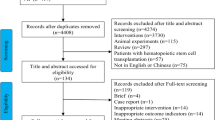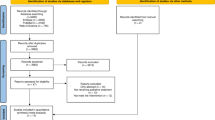Abstract
Objective
To systematically evaluate the impact of physical exercise intervention on children with acute lymphoblastic leukemia (ALL) during the treatment and rehabilitation consolidation periods.
Method
Randomized controlled trials (RCTs) were retrieved from PubMed, Scopus, Web of Science, CNKI, and Cochrane databases, with a search time range from database establishment to September 1, 2023. The quality of the included RCTs was evaluated using the Cochrane risk assessment tool, and a systematic evaluation was conducted using RevMan 5.4. The study has been registered with INPLASY (registration number: 202390100).
Result
A total of 12 RCTs including 423 subjects was included. The meta-analysis results showed that long-term exercise intervention can effectively improve the endurance performance (SMD = 1.37, 95% CI 0.45 to 2.29, p = 0.004), functional mobility (MD = − 1.17, 95% CI − 1.85 to − 0.49, p = 0.0008), cancer-related fatigue (CRF) (MD = − 1.25, 95% CI − 1.69 to − 0.80, p < 0.00001), and quality of life (QOL) (MD = 4.93, 95% CI 1.80 to 8.05, p = 0.002) of ALL children during the treatment and rehabilitation consolidation periods. Its promoting effect on the muscle strength (SMD = 0.53, 95% CI − 0.33 to 1.39, p = 0.23) and bone mineral density (BMD) (SMD = 0.48, 95% CI 0.20 to 0.77, p = 0.05) of the subjects was not significant. Further meta-analysis showed that exercise intervention with a duration of less than 1 year (SMD = 0.91, 95% CI 0.55 to 1.28, p < 0.00001) rather than more than 1 year (SMD = − 0.16, 95% CI − 0.61 to 0.29, p = 0.49) can effectively reduce subject BMD, while in terms of strength, exercise intervention can effectively improve strength during the treatment period (SMD = 0.97, 95% CI 0.40 to 1.54, p = 0.0008) rather than the consolidation period (SMD = − 0.27, 95% CI − 1.08 to 0.53, p = 0.51).
Conclusion
Long-term regular exercise can effectively improve the endurance, functional mobility, CRF, and QOL of children with ALL in the rehabilitation and treatment consolidation stages. Their strength and BMD may be influenced by the timing of treatment and the intervention cycle, respectively. Considering the limited number of included literature and the instability of some outcome indicators, it is necessary to design more comprehensive and rigorous high-quality RCTs in the future to test the exercise efficacy of ALL children.








Similar content being viewed by others
References
DeAngelo DJ, Jabbour E, Advani A (2020) Recent advances in managing acute lymphoblastic leukemia. Am Soc Clin Oncol Educ Book 40:330–342
Dandan Xu, Yang L (2019) Expression levels of miR377- and SMYD3 in patients with acute lymphoblastic leukemia and their clinical prognostic significance. Int J Lab Med 44(17):2129–2133
Davis KL (2022) Understanding the hematopoietic factory during acute lymphoblastic leukemia. Pediatric Res 91(5):1023–1024
Malard F, Mohty M (2020) Acute lymphoblastic leukaemia. Lancet 395(10230):1146–1162
Zhu W, Liu S, Shi Y et al (2023) The epidemic of acute lymphoid leukemia in China: current trends and future prediction. Front Oncol 13:1195065
Naomi S, Charles S, Kayo N et al (2022) Worldwide trends in population- based survival for children, adolescents, and young adults diagnosed with leukaemia, by subtype, during 2000–14 (CONCORD-3): analysis of individual data from 258 cancer registries in 61 countries. The Lancet. Child Adolescent Health 6(6):409–431
Katz AJ, Chia VM, Schoonen WM et al (2015) Acute lymphoblastic leukemia: an assessment of international incidence, survival, and disease burden. Cancer Causes Control 26(11):1627–1642
Siegel RL, Miller KD, Wagle NS et al (2023) Cancer statistics 2023. CA Cancer J Clin 73(1):17–48
Bonaventure A, Harewood R, Stiller CA et al (2017) Worldwide comparison of survival from childhood leukaemia for 1995–2009, by subtype, age, and sex (CONCORD-2): a population-based study of individual data for 89 828 children from 198 registries in 53 countries. Lancet Haematol 4(5):e202–e217
Bhakta N, Liu Q, Ness KK et al (2017) The cumulative burden of surviving childhood cancer:an initial report from the St Jude Lifetime Cohort Study (SJLIFE). Lancet 390(10112):2569–2582
Chen Fuyi Wu, Jieling ML (2019) Long-term Rehabilitation management of childhood acute lymphoblastic leukemia survivors. Cancer Res Prev Treat 49(09):893–898
Xiaowen S, Honghua Z, Xiaofen Z et al (2022) Effect of exercise intervention on cancer-related fatigue in children with acute leukemia during chemotherapy. J Nursing Sci 37(12):72–74
Millan NC, Pastrana A, Guitter MR et al (2018) Acute and sub-acute neurological toxicity in children treated for acute lymphoblastic leukemia. Leuk Res 65:86–93
Shuang H, Zhenling L, Fang C (2019) Research progress of exercise rehabilitation in children with acute lymphoblastic leukemia. Chin J New Clin Med 14(02):143–148
Koelwyn GJ, Zhuang X, Tammela T et al (2020) Exercise and immunometabolic regulation in cancer. Nat Metab 2(9):849–857
Galunas L (2022) The impact of a nurse-led exercise activity for cancer-related fatigue in patients with leukemia. Clin J Oncol Nurs 26(3):257–260
Gheyasi F, Baraz S, Malehi A et al (2019) Effect of the walking exercise program on cancer-related fatigue in patients with acute myeloid leukemia undergoing chemotherapy. Asian Pac J Cancer Prev 20(6):1661–1666
Zhou Y, Zhu J, Gu Z et al (2017) Efficacy of exercise interventions in patients with acute leukemia: a meta-analysis. PLoS ONE 11(7):e0159966
Page MJ, McKenzie JE, Bossuyt PM et al (2021) The PRISMA 2020 statement: an updated guideline for reporting systematic reviews. J Clin Epidemiol 134:178–189
Elnaggar RK, Mohamed RR (2021) Aqua-plyometric exercises: potential implications for bone mineral density, functional capacity, and quality of life in survivors of childhood acute lymphoblastic leukemia. Semin Oncol Nurs 37(6):151225
Essam AM, Mohamed AAS, Fahad MA et al (2023) Effectiveness of exergaming in reducing cancer-related fatigue among children with acute lymphoblastic leukemia: a randomized controlled trial. Ann Med 55(1):2224048
Cox CL, Zhu L, Kaste SC, et al. (2018) Modifying bone mineral density, physical function, and quality of life in children with acute lymphoblastic leukemia. Pediatr Blood Cancer 65(4). https://doi.org/10.1002/pbc.26929
Marchese VG, Chiarello LA, Lange BJ (2004) Effects of physical therapy intervention for children with acute lymphoblastic leukemia. Pediatr Blood Cancer 42(2):127–133
Waked IS, Albenasy KS (2018) Bone mineral density, lean body mass and bone biomarkers following physical exercise in children with acute lymphoblastic leukemia undergoing chemotherapy. IJBC 10(3):69–75
Baky AM, Elhakk SM (2017) Impact of aerobic exercise on physical fitness and fatigue in children with acute lymphoblastic leukemia. Int J Therapies Rehab Res 6(2):137–145
Manchola-González JD, Bagur-Calafat C, Girabent-Farrés M et al (2020) Effects of a home-exercise programme in childhood survivors of acute lymphoblastic leukaemia on physical fitness and physical functioning: results of a randomised clinical trial. Support Care Cancer 28(7):3171–3178
Khodashenas E, Badiee Z, Sohrabi M et al (2017) The effect of an aerobic exercise program on the quality of life in children with cancer. Turk J Pediatr 59(6):678–683
Tanir MK, Kuguoglu S (2013) Impact of exercise on lower activity levels in children with acute lymphoblastic leukemia: a randomized controlled trial from Turkey. Rehabil Nurs 38(1):48–59
Yeh CH, Man WJP, Lin US et al (2011) A pilot study to examine the feasibility and effects of a home-based aerobic program on reducing fatigue in children with acute lymphoblastic leukemia. Cancer Nurs 34(1):3–12
De Macedo TMF, Oliveira KMC, Melo JBDC et al (2010) Inspiratory muscle training in patients with acute leukemia: preliminary results. Revista Paulista de Pediatria 28:352–358
Hartman A, te Winkel ML, van Beek RD et al (2009) A randomized trial investigating an exercise program to prevent reduction of bone mineral density and impairment of motor performance during treatment for childhood acute lymphoblastic leukemia. Pediatric Blood Cancer 53(1):64–71
Zhao WR, Ma ZL, Cheng TY et al (2019) Application of cardiopulmonary exercise test in patients with lung cancer. Chin J Cancer Prev 30(15):941–947
Cowdery SP, Stuart AL, Pasco JA et al (2021) Mood disorder and cancer onset: evidence from a population-based sample of Australian women. Braz J Psychiatry 43(4):355–361
Braam KI, van Dijk-Lokkart EM, Kaspers GJL et al (2016) Cardiorespiratory fitness and physical activity in children with cancer. Support Care Cancer 24(5):2259–2268
Ahn KY, Lee MK, Kim DI et al (2016) Cardiopulmonary fitness, adiponectin, chemerin associated fasting insulin level in colorectal cancer patients. Support Care Cancer 24(7):2927–2935
Parry-Williams G, Sharma S (2020) The effects of endurance exercise on the heart: panacea or poison? Nat Rev Cardiol 17(7):402–412
van der Schoot GGF, Ormel HL et al (2022) Optimal timing of a physical exercise intervention to improve cardiorespiratory fitness: during or after chemotherapy. JACC CardioOncol 18,4(4):491–503
Moran JM, Puerto-Parejo LM, Leal-Hernandezo (2019) Acupuncture for cancer-related fatigue in lung cancer patients: methodological and statistical issues. Supportive Care in Cancer 27(1):1–2
Zhou X, Li X, Wang Z (2022) Impact of individualized intervention on the psychological status of patients with localized small cell lung cancer complicated with pleural effusion. Psychol Health Med 27(6):1326–1333
Zhao J, Qi Q, Xu S et al (2020) Combined aerobic resistance exercise improves dialysis adequacy and quality of life in patients on maintenance hemodialysis. Clin Nephrol 93(6):275–282
Acknowledgements
I would like to thank and the leaders and colleagues of the School of Physical Education of Southwest University for their selfless contributions and help to this research.
Funding
This project is supported by the Humanities and Social Science Foundation of the Ministry of education (Project No: 20YJA890018).
Author information
Authors and Affiliations
Contributions
Hengxu Liu and Jingqi Yin was in charge of proposing topics and writing articles;Kun Wang,Shiqi Liu,Yi Yang,Ziyi Song,Caiyun Dong,Tingran Zhang,Jiong Luo was primarily responsible for retrieving, collecting data,drawing graphs and revising articles.All authors have read and agreed to the published version of the manuscript.
Corresponding authors
Ethics declarations
Competing interests
The authors declare no competing interests.
Additional information
Publisher's Note
Springer Nature remains neutral with regard to jurisdictional claims in published maps and institutional affiliations.
Author statement
The work described has not been submitted elsewhere for publication in whole or in part and the authors claim that none of the material in the paper has been published or is under consideration for publication elsewhere.
Tingran Zhang and Jiong Luo are co corresponding authors.
Rights and permissions
Springer Nature or its licensor (e.g. a society or other partner) holds exclusive rights to this article under a publishing agreement with the author(s) or other rightsholder(s); author self-archiving of the accepted manuscript version of this article is solely governed by the terms of such publishing agreement and applicable law.
About this article
Cite this article
Liu, H., Yin, J., Wang, K. et al. Efficacy of physical exercise intervention on children with acute lymphoblastic leukemia during treatment and rehabilitation: a systematic review and meta-analysis. Support Care Cancer 32, 177 (2024). https://doi.org/10.1007/s00520-024-08355-z
Received:
Accepted:
Published:
DOI: https://doi.org/10.1007/s00520-024-08355-z




